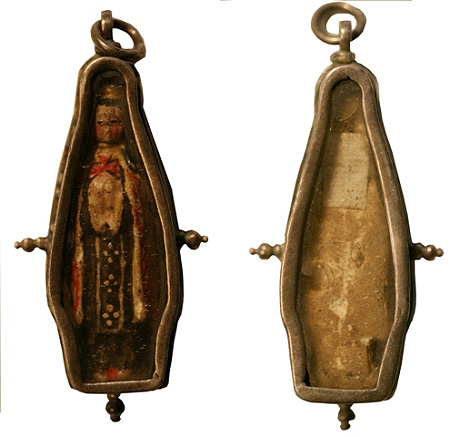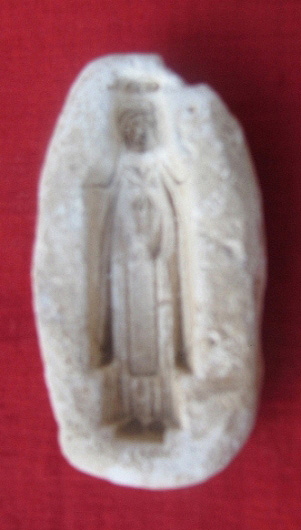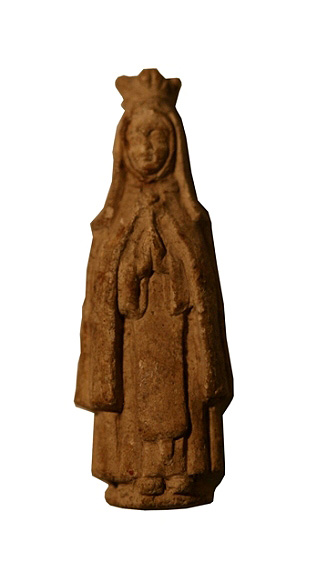Piece of the month October 2010
RELIQUARY CASE WITH CROWNED NUN
Ignacio Miguéliz Valcarlos
Chair of Navarrese Heritage and Art
In the treasure of Our Lady of the Tabernacle of the cathedral of Pamplona is conserved a reliquary case carved in silver in its color that contains in its interior a delicate wax figurine that represents a nun. It is a work of small dimensions (6,7 x x ,2 cm.), elaborated in Navarrese workshops during the XVIII century, in which the work of a master silversmith in the realization of the case is combined with the work of conventual craftsmanship in the figure of the nun.
This is an articulated work in the form of a mixtilinear box that adapts to the effigy inscribed inside it, which indicates that it was made specifically to house the image, and not a later adaptation of a pre-existing case. It has a double stained-glass window, with a straight moulding running along its profilethat divides it into two symmetrical parts, each decorated with a triangular zigzag border, alternating smooth-surfaced elements with others with a striped interior, with a perinola on the axes, except for the upper one, which has a bias handle with a loop. Inside, the obverse window contains the wax figure of a crowned nun with her hands clasped on her chest in a praying pose. This figurine is dressed in a tunic, headdress and veil, adorned with a rich polychrome in black, red and white tones, with a crown on her head, perhaps alluding to the crowns of flowers that the nuns wore on the day of their entrancein community and on their death. Both the crown and the ribbons that hold the cloak, as well as the ornamental motifs on it, with their rich red polychromy, are reminiscent in their simplicity of the famous crowned nuns of New Spain. The window on the back sampleshows the relic itself, in this case Pasti di reliquii, subjectwhich originated from the bodies of the martyrs found in the Roman catacombs. When the name of the martyr was unknown, his body was exhumed in the presence of a vicar and exposed to public veneration in a church, after which his bones were reduced to powder and mixed with wax, thus forming the so-called relic paste, which was later exported and used to make different types of reliquaries, especially in convents, where they were very popular, especially in the cloistered sphere.

Reliquary case with crowned nun. Obverse and reverse. 18th century. Pamplona. Cathedral.
This subjectof reliquaries, a clear exponent of popular religiosity and convent art, was made in the cloister by the nuns themselves, using plaster moulds. The cast was made in clay or wax, and once extracted and retouched, it gave rise to multiple possibilities: effigies to hang in the rosary, figures to give to visitors, and even, as in this case, they were included in small silver reliquaries for devotion staff. There are different variants of this subjectof reliquaries, which generally inscribed inside them images of great delicacy, such as those incorporating representations of the Child Jesus, some of them of greater wealth, such as the so-called Niños filipinos, little ivory figurines of Philippine origin, as their name indicates, which were either placed in cases made especially for them, or were adapted to already made boxes or jewellery boxes. Many of these pieces were taken out of the cloisters as presents and gifts to relatives and benefactors of the convents and monasteries where they were made. These works were used as relic cases, not only for devotional purposes, but also acquired the characteristics of sumptuary objects and ornaments staff, thanks to the rich materials in which some of them were made. They were also pieces of a thaumaturgical nature, in which divine protection was sought, intermingling the religious sense with the superstitions and popular beliefs so typical of the centuries of the Ancien Régime.
An important centre for the production of these figures in Navarre was the convent of the Discalced Carmelites of Araceli in Corella, one of the most traditional cloistered monasteries in Navarre in terms of the presence and dissemination of popular religiosity, where a plaster mould has been preserved which is very similar to the figure of the nun inscribed in this reliquary. These nuns, from the very moment of their foundation, stood out for the creation of this subjectof images, which they used both for internal use and consumption, as well as for the satisfaction of their superiors, benefactors and relatives, reaching their maximum expression in the creation of chapels, reliquaries and altar reductions in the manner of small theatres. We also find figures similar to this one in another cloister in Navarre, the Augustinian Recollect Nuns of Pamplona, whose nuns still conserve several figurines of this type subject, both clay and plaster moulds, which indicates how widespread the tradition of making this type of figure subjectwas in the cloistered environment, within the parameters of what could be called conventual art. Among the pieces preserved in the Pamplona monastery are a free-standing unpolychromed and untreated clay figure very similar to the one in Pamplona Cathedral, as well as a showcase with the topicof the tomb of Christ, in which one of these nuns is inserted.

Plaster mould of a crowned nun. 18th century. Corella.
Convent of the Carmelites of Araceli.
This reliquary box is one of the most recent additions to the treasure of the Virgen del Sagrario, as it was donated, along with other pieces, in November 2005 by the descendants of the birthplace of Erratzu of two Navarrese bishops, Juan Lorenzo de Irigoyen y Dutari (1712-1778), bishop of Pamplona, and Miguel José de Irigoyen y Dolarea (1785-1852), who was bishop of Zamora and Calahorra - La Calzada. As we have seen, it is not surprising that these subjectpieces belonged to a prelate, as they were a prized gift from the religious communities that made them to different personalities related to them. positionProbably, and due to its chronology, this work would have originally belonged to Juan Lorenzo de Irigoyen y Dutari, who governed the destinies of the see of Pamplona between 1768 and 1778, having previously held the position of canon of the cathedral of Jaén, a post which he exchanged in 1747 for the priory of Belate, one of the dignities associated with the cathedral canons of Pamplona.

Clay figure of a crowned nun. 18th century. Pamplona.
Convent of Augustinian Recollect Nuns.
bibliography
- ARBETETA MIRA, L., La joyería española de Felipe II a Alfonso XIII, Madrid, Nerea, 1998.
- CEA GUTIÉRREZ, A., El tesoro de las reliquias. Colección de la Abadía Cisterciense de cañas, Logroño, Caja Rioja, 1999.
- MERLO JUÁREZ, E., "Reliquiae", Santuarios de lo íntimo. Miniature portraits and reliquaries. La colección del Museo Soumaya, Mexico, Telmex, 2004.
